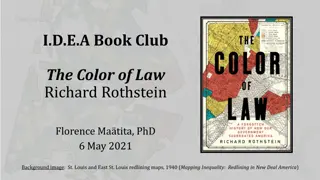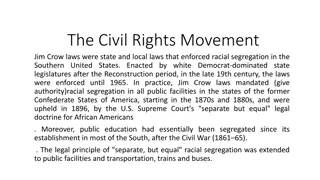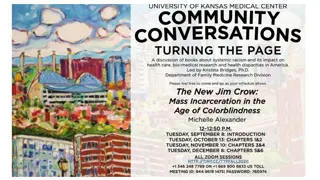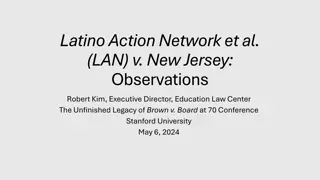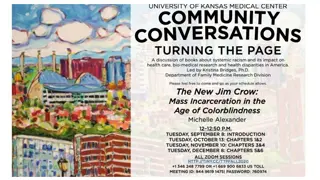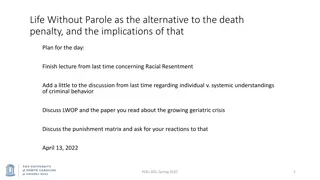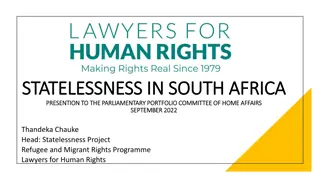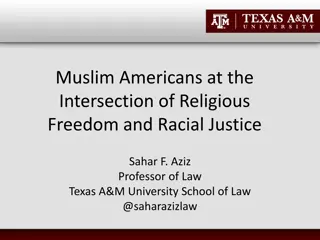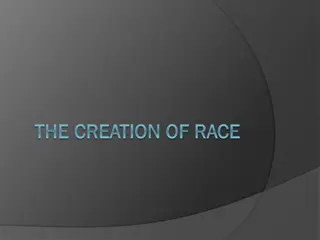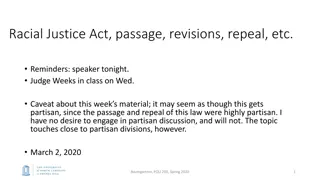Understanding Early Racial Segregation in South Africa
Explore the historical background of racial segregation in South Africa before apartheid, focusing on the Land Act and the Colour Bar Act. Learn about the impact on the Black community, benefits to the White community, and how these laws shaped the socio-economic landscape. Gain insights into the injustices faced by Black South Africans through discriminatory legislation.
Download Presentation

Please find below an Image/Link to download the presentation.
The content on the website is provided AS IS for your information and personal use only. It may not be sold, licensed, or shared on other websites without obtaining consent from the author. Download presentation by click this link. If you encounter any issues during the download, it is possible that the publisher has removed the file from their server.
E N D
Presentation Transcript
LESSON 1: RACIAL SEGREGATION BEFORE APARTHEID THE LAND ACT AND THE COLOUR BAR ACT.
OUTCOMES LEARNERS WILL BE ABLE TO: Define segregation. Outline the clauses of the land and colour bar acts. Assess the impact of the land and colour bar acts on the blacks. Explain how the land and colour bar acts benefited the white community.
PRE - KNOWLEDGE LEARNERS ALREADY KNOW THE FOLLOWING: The definition and concept of apartheid. The characteristic features of apartheid. That apartheid was introduced in 1948.
DIRECT INSTRUCTION:LECTURE METHOD (5 MINUTES) While apartheid was introduced in 1948, some of its aspects like segregation had existed in South Africa well before that. After the British had defeated the Boers in the South African war of 1899 to 1901, the Union of South Africa was formed. The two former Boer Republics of the Transvaal and the Orange Free State and the British colonies of the Cape and Natal became a British dominion with power vested in the hands of the white people. The British reneged on their promise to grant Black South Africans rights in the war aftermath. Segregation laws were passed which resulted in segregation in land ownership, in the work place, access to towns and cities and in the administrative system.
GUIDED PRACTICE:PAIR WORK (15 MINUTES) EARLY RACIAL SEGREGATION: THE JOB COLOUR BAR AND THE 1913 NATIVES LAND ACT The first government of the Union quickly began the process of passing new laws that strengthened segregation. The 1911 Mines and Works Act stated that black people could not be placed in positions of authority over white people. Black people could not be managers or foremen in the mines and factories. This ensured good positions for the white workers and gave them the advantage of high earnings. This was known as the job colour bar as it barred (prevented) the black people from certain jobs. In the 1920s many white people were very poor. The then Prime minister Hertzog introduced the civilised labour policy which was also known as the policy of affirmative actionfor white people. White people were given jobs rather than black people and a white person was paid more for doing the same job as a black person. In 1913, the government passed the Natives Land Act. This law allowed Africans to own land only n certain areas called reserves. All the reserves together amounted to about seven percent of South Africa s land. This was increased to 13 percent in 1936.The reserves were located far apart and were surrounded by white owned farms. The act gave white farmers access to more land and to cheap farm labour which was provided by the now dispossessed black people who no longer had land. Africans were denied ownership or access to land to farm for themselves. The act destroyed the independence of Black farmers. Overnight thousands of families were forced to leave their land and move to the infertile overcrowded reserves. This forced adults in most families to look for work on the white owned farms or towns or cities.
GUIDED PRACTICE:PAIR WORK (continued) Activity 1 1.1. Describe what you see in the picture below. 1.2. In what way it illustrates the civilised labour policy.
GUIDED PRACTICE:PAIR WORK (continued) Activity 1 Study the sources below and then answer the questions that follow. Source A Europeans must keep to a standard of living which meets the demands of white civilisation. Civilisation and standards of living always go hand in hand. Thus a white can not live on a native wage, because this means that he has to give up his own standard of living. Prime minister Hertzog in a speech to parliament in 1924. Source B The job colour bar meant that some people would be employed even if they were not the best candidate for the job. By the 1930s the black community experienced deepening poverty; black people suffered disadvantages as a result of the government s civilised labour policy ..A white skin became a better recommendation for a job than a person s ability. 1.3. In source A, why does Hertzog think that white people should be paid more than black people? 1.4. According to source B, why couldn t black people get jobs? 1.5. What were the results of government s civilised policy on black people according to source B? 1.6. How did white people benefit from the civilised labour policy according to the source?
GUIDED PRACTICE:PAIR WORK (continued) Source C The most severe law was the 1913 Land Act, which prevented Africans from buying, renting or using land except in the reserves. Many communities or families immediately lost their land because of the Land Act. For millions of other black people it became very difficult to live off the land. The Land Act caused overcrowding, land hunger, poverty and starvation. Source D
GUIDED PRACTICE:PAIR WORK (continued) 1.7. Refer to source C. What was the land Act? 1.8. According to the source, why was the Land Act such a severe law? 1.9. How does source D support the information given in source C in terms of: a) The amount of land available ? b) The way that the land was distributed?
CLOSURE: TEACHER LED CLASS DISCUSSION (10 MINUTES) MEMORANDUM 1.1. Five men working in what appears to be a mine. Four of them are black and one is white. The black men are all holding tools. 1.2. The white man does not have any tool in his hand, indicating that he is a supervisor. He is wearing a long shirt and a waist coat which is not appropriate dress for mine work. 1.3. The white man s standard of living is much higher than that of the black man. He therefore needs a higher wage in order to sustain the standard otherwise he will have to live like a black man whose standards are lower if he gets a low wage. 1.4. Because they were black. Preference was given to white people when hiring. 1.5. They became very poor. 1.6. They got jobs even if they were not qualified. 1.7. It was the act that was passed by the Union government in 1913 which set aside 13% of all land for use by black people. 1.8. a)The map shows that the land allocated to the black people was very little and could not sustain them. b) The reserves were located far apart and were surrounded by white farmland.
INDEPENDENT PRACTICE: (Home work) 1. In a paragraph, explain how the following impacted on and discriminated against black people: a) The 1913 Land Act. b) The colour bar policy.
INDEPENDENT PRACTICE: (Memorandum) a) The Land Act prohibited black people from buying or renting land in white land. It impacted badly on the black people as they lost their land and had to live in overcrowded reserves. Because the land could no longer sustain them, most black people were forced to work in the white owned factories and farms. They lost their independence and had to become labourers for the white man. b) The colour bar policy led to unemployment among the black people. White people were hired first before them even if they were better suited for the job. They were paid far less than the white men who were doing the same jobs. This led to serious problems of poverty and starvation.


